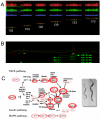O-GlcNAc cycling: emerging roles in development and epigenetics
- PMID: 20488252
- PMCID: PMC2917487
- DOI: 10.1016/j.semcdb.2010.05.001
O-GlcNAc cycling: emerging roles in development and epigenetics
Abstract
The nutrient-sensing hexosamine signaling pathway modulates the levels of O-linked N-acetylglucosamine (O-GlcNAc) on key targets impacting cellular signaling, protein turnover and gene expression. O-GlcNAc cycling may be deregulated in neurodegenerative disease, cancer, and diabetes. Studies in model organisms demonstrate that the O-GlcNAc transferase (OGT/Sxc) is essential for Polycomb group (PcG) repression of the homeotic genes, clusters of genes responsible for the adult body plan. Surprisingly, from flies to man, the O-GlcNAcase (OGA, MGEA5) gene is embedded within the NK cluster, the most evolutionarily ancient of three homeobox gene clusters regulated by PcG repression. PcG repression also plays a key role in maintaining stem cell identity, recruiting the DNA methyltransferase machinery for imprinting, and in X-chromosome inactivation. Intriguingly, the Ogt gene resides near the Xist locus in vertebrates and is subject to regulation by PcG-dependent X-inactivation. OGT is also an enzymatic component of the human dosage compensation complex. These 'evo-devo' relationships linking O-GlcNAc cycling to higher order chromatin structure provide insights into how nutrient availability may influence the epigenetic regulation of gene expression. O-GlcNAc cycling at promoters and PcG repression represent concrete mechanisms by which nutritional information may be transmitted across generations in the intra-uterine environment. Thus, the nutrient-sensing hexosamine signaling pathway may be a key contributor to the metabolic deregulation resulting from prenatal exposure to famine, or the 'vicious cycle' observed in children of mothers with type-2 diabetes and metabolic disease.
Published by Elsevier Ltd.
Figures





Similar articles
-
Drosophila O-GlcNAcase Deletion Globally Perturbs Chromatin O-GlcNAcylation.J Biol Chem. 2016 May 6;291(19):9906-19. doi: 10.1074/jbc.M115.704783. Epub 2016 Mar 8. J Biol Chem. 2016. PMID: 26957542 Free PMC article.
-
You are what you eat: O-linked N-acetylglucosamine in disease, development and epigenetics.Curr Opin Clin Nutr Metab Care. 2015 Jul;18(4):339-45. doi: 10.1097/MCO.0000000000000188. Curr Opin Clin Nutr Metab Care. 2015. PMID: 26049631 Free PMC article. Review.
-
Nutrient-driven O-GlcNAc cycling - think globally but act locally.J Cell Sci. 2014 May 1;127(Pt 9):1857-67. doi: 10.1242/jcs.113233. Epub 2014 Apr 24. J Cell Sci. 2014. PMID: 24762810 Free PMC article.
-
Caenorhabditis elegans ortholog of a diabetes susceptibility locus: oga-1 (O-GlcNAcase) knockout impacts O-GlcNAc cycling, metabolism, and dauer.Proc Natl Acad Sci U S A. 2006 Aug 8;103(32):11952-7. doi: 10.1073/pnas.0601931103. Epub 2006 Aug 1. Proc Natl Acad Sci U S A. 2006. PMID: 16882729 Free PMC article.
-
The potential role of O-GlcNAc modification in cancer epigenetics.Cell Mol Biol Lett. 2014 Sep;19(3):438-60. doi: 10.2478/s11658-014-0204-6. Epub 2014 Aug 20. Cell Mol Biol Lett. 2014. PMID: 25141978 Free PMC article. Review.
Cited by
-
O-GlcNAcylation in Renal (Patho)Physiology.Int J Mol Sci. 2022 Sep 24;23(19):11260. doi: 10.3390/ijms231911260. Int J Mol Sci. 2022. PMID: 36232558 Free PMC article. Review.
-
Restriction of Cellular Plasticity of Differentiated Cells Mediated by Chromatin Modifiers, Transcription Factors and Protein Kinases.G3 (Bethesda). 2019 Jul 9;9(7):2287-2302. doi: 10.1534/g3.119.400328. G3 (Bethesda). 2019. PMID: 31088904 Free PMC article.
-
Glucose metabolism and hexosamine pathway regulate oncogene-induced senescence.Cell Death Dis. 2014 Feb 27;5(2):e1089. doi: 10.1038/cddis.2014.63. Cell Death Dis. 2014. PMID: 24577087 Free PMC article.
-
Genome-wide mRNA and microRNA profiling of the NCI 60 cell-line screen and comparison of FdUMP[10] with fluorouracil, floxuridine, and topoisomerase 1 poisons.Mol Cancer Ther. 2010 Dec;9(12):3105-14. doi: 10.1158/1535-7163.MCT-10-0674. Mol Cancer Ther. 2010. PMID: 21159603 Free PMC article.
-
O-GlcNAc cycling modulates neurodegeneration.Proc Natl Acad Sci U S A. 2012 Oct 23;109(43):17319-20. doi: 10.1073/pnas.1215395109. Epub 2012 Oct 9. Proc Natl Acad Sci U S A. 2012. PMID: 23047690 Free PMC article. No abstract available.
References
-
- Love D, Hanover J. The hexosamine signaling pathway: deciphering the “O-GlcNAc code”. Sci STKE. 2005;2005:re13. - PubMed
-
- Kelly W, Hart G. Glycosylation of chromosomal proteins: localization of O-linked N-acetylglucosamine in Drosophila chromatin. Cell. 1989;57:243–251. - PubMed
-
- Kelly W, Dahmus M, Hart G. RNA polymerase II is a glycoprotein. Modification of the COOH-terminal domain by O-GlcNAc. J Biol Chem. 1993;268:10416–10424. - PubMed
Publication types
MeSH terms
Substances
Grants and funding
LinkOut - more resources
Full Text Sources
Molecular Biology Databases
Research Materials
Miscellaneous

